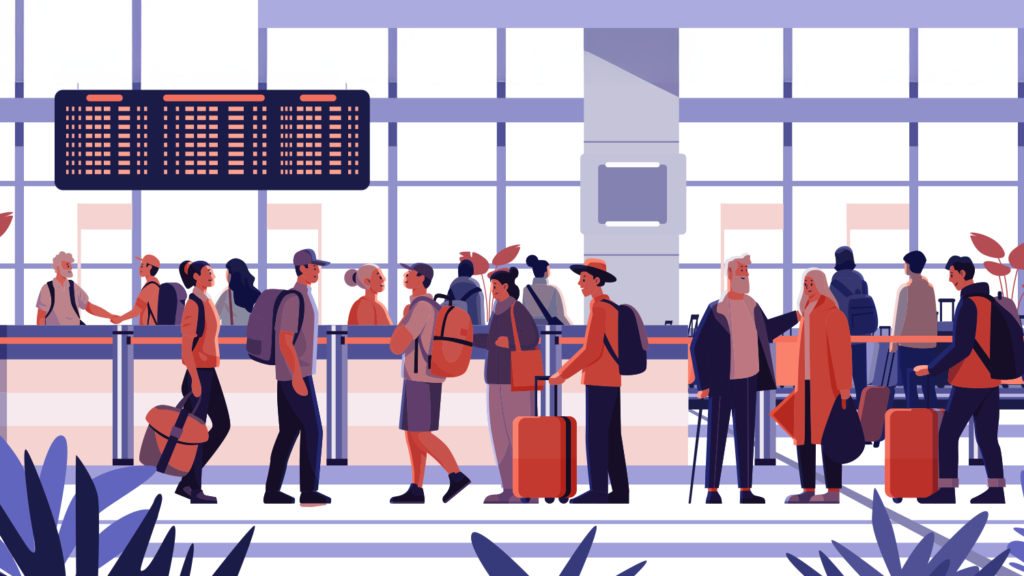
While the swift post-pandemic economic recovery that many had hoped China would see has failed to materialise, the return of international travel to the country has, so far, stood out as a relative success. Instead of a simple reopening, policymakers have gone to great lengths to undo damage done by several years of travel restrictions under the zero-COVID policy, with a rollout of visa optimisations as well as other policies aimed at making it easier for foreign nationals to visit China. In this article, Austin Bliss of the European Chamber outlines the steps taken and the challenges that remain.
The measures the Chinese Government has taken to ease travel to China since the end of its zero-COVID policy have already had a meaningful impact, but it will take time before their full effect is felt. 2024 marked the first full calendar year since 2019 that travel to China was free of COVID-19 restrictions.[1] While the zero-COVID policy came to an end in late 2022, lingering COVID requirements for international travellers for most of 2023, as well as the time needed for international flight schedules to recover, meant that the year was more of a soft reopening.[2]
On 1st December 2023, the tone began to change when China unilaterally extended visa-free access to five European Union (EU) Member States – a surprising development which meant that in less than a year, the country went from banning visits by most foreign travellers to proactively offering visa-free travel. Throughout 2024, China made additional announcements on visa-free travel, ultimately expanding the offering to all but three EU Member States.
Riding a wave of announcements about visa-free travel and a clean break from COVID restrictions,[3] 2024 saw 64.9 million entries and exits by foreign nationals, an 82.9 per cent jump compared to 2023 according to the National Immigration Administration (NIA).[4] However, the figure is still short of the 97.7 million entries and exits reported by the NIA in 2019,[5] the last year unaffected by COVID-19 travel restrictions, indicating that a full recovery has yet to be achieved.
Visa-free policies
China saw over 20 million visa-free arrivals in 2024 according to the NIA,[6] meaning that a majority of foreign nationals who visited the country benefitted from this policy,[7] indicative not only of the convenience of visa-free travel, but also the relative inconvenience of having to obtain a visa.
The visa-free regime that applies to 24 of the 27 EU Member states is straightforward, providing access to all of the Chinese mainland—except where other restrictions on foreign nationals apply[8]—for 30 days if the trip is for business, tourism, visiting family and friends, transit or some other types of exchanges.
However, the decision to withhold the privilege from three EU Member States for what appears to be political reasons, as well as the fact that the scheme is temporary and must be renewed,[9] raises doubts about whether it will continue to be available to travellers in the long-term.
China’s second visa-free scheme, which provides 10-day transit without visa (TWOV) access to individuals from 54 countries—including all EU Member States—offers an alternative way to visit most of the country without the need to obtain a visa. The scheme requires that travellers arrive from and depart to different countries or regions for their stay in China to be considered eligible for TWOV.
Currently, the 10-day TWOV scheme is only applicable to nine countries in practice, given that the other 45 countries that have access to the scheme also have regular visa-free travel privileges.[10] However, the fact that China still maintains that the scheme is applicable to 54 countries suggests that it would serve as an alternate, less convenient option should one of the other 45 countries lose access to regular visa-free travel.
The TWOV scheme—which has long been criticised for its complexity—saw a significant upgrade in late 2024 when the limit of stay was extended from six to 10 days and the various regions of stay were abolished, allowing travellers to move freely between participating cities and provinces for the first time.[11] However, the scheme still only applies to certain ports of entry and travellers are required to stay within cities and provinces that participate, although some exceptions are possible for transit between regions.[12]
While the upgraded TWOV scheme allows for greater flexibility, given that users can now choose to, for example, arrive in Beijing and depart from Shanghai, its implementation still presents challenges. Users of the scheme continue to report that some airline staff overseas are unfamiliar with its details, hindering their ability to approve TWOV passengers for boarding. Once TWOV passengers arrive in China, many report difficulties identifying the correct immigration queue for TWOV due to unclear signage and airport staff unable to communicate in English. This is followed by lengthy wait times to process relevant paperwork, which is significantly more burdensome than for passengers arriving with a visa or who qualify for visa-free travel.
Adding a further layer of complexity, in addition to the 10-day TWOV scheme, China operates a 24-hour TWOV scheme available to all nationalities at all ports of entry, [13] however in practice certain ports of entry may be excluded.[14] Additionally, the 24-hour TWOV does not guarantee the ability to leave the port area, and specific requirements for obtaining an entry permit on arrival may not be clear in advance.
To add a final layer of complexity, beyond TWOV, China offers several other regional visa-free schemes, including some for tour groups as well as full visa-free entry to Hainan Province for 59 nationalities.[15]
While this expanding menu of visa-free offerings—tailored to different needs and situations—has made China more open for travel overall, its convenience can be lost on travellers, many of whom are accustomed to more straightforward visa-free travel offerings by other countries.
Accommodating foreign visitors
Throughout 2024, China rolled out a basket of policies aimed at ensuring a smoother experience for foreign visitors once they arrive in the country. Much like its visa-free schemes, good intentions often give way to complex interpretations and mixed experiences for users.
One of the most urgent problems foreign visitors face when arriving in China is payment. The near total transition to WeChat and Alipay payment in China’s cities has left many visitors—who are accustomed to using either cash or card to pay in essentially every other country in the world—frustrated.
While a concerted effort has been made to improve support for foreign credit cards in business and tourist destinations, most visitors will struggle to rely on only a card during their trip. Cash is widely accepted, as Chinese law makes it illegal to refuse it, but merchants rarely have change, making its usefulness limited in practice.

This leaves visitors with no option but to download WeChat or Alipay and link their account with a foreign card for payment. While the process of linking foreign cards on the platforms has improved, the inability to make transactions with personal accounts remains a barrier, as some smaller merchants use them to collect payment. Furthermore, the time spent setting up accounts on either of the platforms and ensuring that they work reliably is significant. This may be worthwhile for a tourist planning an extended trip but is less attractive for a business traveller with just a few days in the country.
Another problem that has been addressed but remains unsolved is unequal treatment in hotel accommodation, a long-standing issue in China where some hotels refuse to allow foreign nationals to check in. In May 2024, the Ministry of Public Security released a statement confirming that hotels could not turn down foreign nationals “on the grounds of not having foreign-related qualifications,”[16] a reason often cited for refusing to accommodate foreign nationals. Despite the announcement, travellers continue to report that some hotels, including in cities popular with foreign visitors, still refuse to provide accommodation.[17]
The root of the problems lies in the fact that foreign travellers, as well as most foreign residents in China, rely on a passport for identification. Hotels, which are required to register all guests with the police, have systems in place to quickly process guests with Chinese resident identity cards—a type of national identity card—but must invest additional resources to process passports. While this can often be as simple as taking a photo of the document and sending it to police, the requirements vary locally, and hotels must work with authorities to ensure they are compliant. Hotels that see few foreign visitors or are unwilling to invest the additional resources to train staff often simply turn passport holders away.

However, hotel accommodation is only one of many seemingly immovable barriers foreign travellers can face. In the wake of a highly digitalised response to the COVID-19 pandemic, China has become increasingly saturated with online systems required for everything from ordering a coffee to visiting tourist attractions. While Alipay’s translation function provides a way for users with no knowledge of Chinese to use many of these systems, real-name registration requirements, including registration with a Chinese phone number still leave many services out of reach.
Even when services offer English-language options, travellers often find themselves unable to use them. One example of this is China’s 12306 railway ticket platform. Although the 12306 app offers an English interface, users who attempt to conduct real-name verification in English consistently report that the app crashes, meaning that in practice it is only possible to first complete verification in Chinese before switching to English. This bug effectively forces travellers who cannot read Chinese to buy tickets through an external agency for a hefty fee or head to a station and queue to purchase a ticket at the counter.
Some Chinese cities have attempted to address the complex web of services travellers must set up and use for their stay in China by opening service centres for foreign visitors at international airports. While the centres appear to be popular, limited locations and opening hours mean that they can only capture a small portion of travellers. Furthermore, even with help, travellers must be willing to invest a significant amount of time setting up and learning about different services before they can enjoy any degree of convenience.
Steps in the right direction
While it is commendable that China has made the effort to welcome additional travellers through a basket of visa-free policies, the complexity of the various schemes means that some travellers will inevitably experience problems using them. The ongoing expansion of regular visa-free travel, however, is a promising signal that China will continue to move towards being a more open and straightforward travel destination. One additional positive step would be for China to move from temporary visa-free access for EU Member States to a permanent scheme that does not need to be renewed.
WeChat and Alipay’s improved useability for foreign visitors is another positive step that has allowed some independent travellers to complete basic tasks, but for the time being attempting anything more complex than ordering lunch will remain a daunting task for most visitors. Even visiting major international tourist attractions like Tian’anmen Square and the Forbidden City, something that was as simple as showing up and queuing before the pandemic, now requires travellers to either navigate a complex online registration process on their own or pay an agency to help them secure tickets.
China—in its uniqueness and complexity—will likely continue to remain a challenging destination for first-time visitors. It is clear, however, that the effort made so far to make it more accessible has delivered tangible benefits that go some way to offsetting the reputational damage done by the country’s COVID-19 travel restrictions. However, a significant and ongoing investment needs to be made before the country can return to pre-COVID levels of accessibility.
Austin Bliss is a
policy and communications coordinator at the European Chamber’s Beijing
Chapter.
[1] Selected travellers still underwent mandatory Covid-19 testing on arrival during 2024, but no action was required by the traveller prior to departure.
[2] Regular visa issuance did not resume until March 2023, meaning that for a quarter of 2023 international travel was still heavily curtailed. Covid tests for international travellers—first PCR tests and later rapid antigen tests—were required until late August 2023 and health declarations were required until 1st November 2023. While these lingering restrictions were a significant improvement over lengthy quarantines, they still presented additional barriers to travel. See: Consular Department of the Ministry of Foreign Affairs: Starting from 15 March, the visa authorities resumed issuing all kinds of visas for foreigners to go to China, Chinanews.com, 14th March 2023, viewed 27th May 2025, <https://www.chinanews.com.cn/gn/2023/03-14/9970999.shtml>;
General Administration of Customs: Nucleic Acid or Antigen Tests Not Required for Entry of Persons from 30 August onwards, Xinhua, 29th August 2023, viewed 27th May 2025, <https://www.gov.cn/zhengce/jiedu/tujie/202308/content_6900830.htm>;
General Administration of Customs Announcement No. 151 of 2023 (Announcement on Optimising and Adjusting the Health Declaration Model), General Administration of Customs, 26th October 2023, viewed 27th May 2025, <http://gdfs.customs.gov.cn/customs/302249/2480148/5457761/index.html>
[3] Selected travellers still underwent mandatory Covid-19 testing on arrival during 2024, but no action was required by the traveller prior to departure.
[4] 610 million entries and exits in 2024, up 43.9 per cent year-on-year, National Immigration Administration, 14th January 2025, viewed 27th May 2025, <https://www.nia.gov.cn/n741440/n741567/c1693512/content.html>
[5] 670 million arrivals and departures in 2019, National Immigration Administration, 6th January 2020, viewed 27th May 2025, <https://www.nia.gov.cn/n741440/n741567/c1199336/content.html>
[6] 610 million entries and exits in 2024, up 43.9 per cent year-on-year, National Immigration Administration, 14th January 2025, viewed 27th May 2025, <https://www.nia.gov.cn/n741440/n741567/c1693512/content.html>
[7] The NIA reported only the number of visa-free entries, while it reported a combined exit and entry figure for foreign nationals overall. Given that 20 million visa-free entries entails about 20 million subsequent exits, it is likely that the majority of the 64.9 million foreign national entries and exits came from visa-free travellers. Ibid.
[8] Foreign nationals must obtain a permit to visit Tibet. Other parts of China, including parts of Qinghai, Sichuan, Xinjiang and some border regions, are often closed to foreign nationals in practice.
[9] Wong, H, and Zhang, P, China is visa-free for most of Europe, but not this EU trio. Why?, South China Morning Post, 29th December 2024, viewed 27th May 2025, <https://www.scmp.com/news/china/diplomacy/article/3292573/china-visa-free-most-europe-not-eu-trio-why>
[10] Czechia, Lithuania, Sweden, Russia, the United Kingdom, Ukraine, the United States, Canada and Mexico are the only countries that qualify for TWOV and do not also have access to regular visa-free travel.
[11]Announcement by the National Immigration Administration on Further Relaxing and Optimising the Visa-Free Transit Policy for Foreigners, NIA, 17th December 2024, viewed 30th May 2025, <https://www.nia.gov.cn/n741440/n741542/c1688980/content.html>
[12] A representative of the NIA’s assistance hotline confirmed that travellers may take a train that passes through an area excluded from the scheme in order to travel to another region covered by the scheme, provided they do not disembark the train outside the permitted travel area.
[13] Visa-Free Transit Policies for Foreign Nationals, NIA, 3rd July 2024, viewed 30th May 2025, <https://en.nia.gov.cn/n147418/n147463/c156086/content.html>
[14] There are reports of travellers being unable to use the 24-hour TWOV scheme at some points of entry, including airports in Huangshan (TXN), Mudanjiang (MDG), Xiamen (XMN) and Urumqi (URC).
[15] Regional Visa-Free Entry Policies for Foreign Nationals, NIA, 14th February 2025, viewed 30th May 2025, <https://en.nia.gov.cn/n147418/n147463/c180637/content.html>
[16] Ministry of Public Security and other departments respond to comments regarding ‘inconveniences faced by foreign tourists staying at hotels’, State Council, 24th May 2024, viewed 30th May 2025, <https://www.gov.cn/hudong/202405/content_6952770.htm>
[17] Wang, S, Hotels in China continue to knock back foreign tourists, ABC News, 4th May 2025, viewed 5th June 2025, <https://www.abc.net.au/news/2025-05-04/hotels-in-china-continue-to-knock-back-foreign-tourists/105229128>


Recent Comments